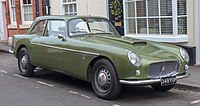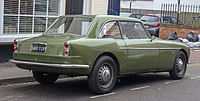
Bristol Cars was a British Manufacturer of hand-built luxury cars headquartered in Bristol, England. It was formed from the car division of the Bristol Aeroplane Company after the Second World War and later became independent as Bristol Cars Limited. After being placed in receivership and being taken over in 2011, it entered liquidation in February 2020.

The Peugeot 405 is a large family car released by the French automaker Peugeot in July 1987, and which continues to be manufactured under licence outside France, having been discontinued in Europe in 1997. It was voted European Car of the Year for 1988 by the largest number of votes in the history of the contest. About 2.5 million vehicles have been sold worldwide, both in LHD and RHD, as a saloon and estate. In early 2020, the 33-year production run of the Peugeot 405 was counted as the twentieth most long-lived single generation car in history."
Armstrong Siddeley was a British engineering group that operated during the first half of the 20th century. It was formed in 1919 and is best known for the production of luxury vehicles and aircraft engines.

The Chrysler Sigma is a version of the Mitsubishi Galant automobile that was built by Chrysler Australia in Adelaide, South Australia from 1977. When Mitsubishi Motors Australia (MMAL) took over Chrysler Australia's manufacturing facilities in 1980, they renamed the vehicle the Mitsubishi Sigma. The range was progressively discontinued and replaced by the Mitsubishi Magna, starting with the sedan in 1985 and the wagon in 1987.
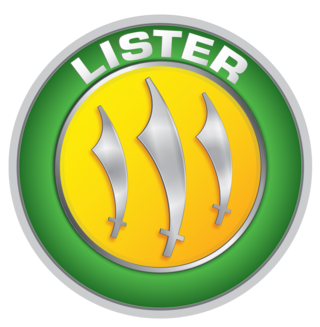
The Lister Motor Company Ltd. is a British sports car manufacturer founded by Brian Lister in 1954 in Cambridge, England, which became known for its involvement in motorsport. After buying the company in 1986, Laurence Pearce produced variants of the Jaguar XJS before producing a bespoke sports car, the Lister Storm. In 2013, Lister Cars was acquired by Lawrence Whittaker's company Warrantywise. Production of the original sports car restarted in 2014 and ten continuation Lister Jaguar Knobblys were built to celebrate Lister's 60th Anniversary. In 2016, the company announced the build and sale of the Lister Knobbly Stirling Moss. On 31 January 2018, the Lister LFT-666 based on the Jaguar F-Type was announced.
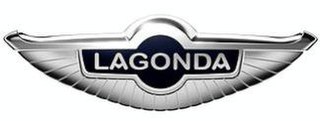
Lagonda is a British luxury car brand established in 1906, which has been owned by Aston Martin since 1947. The trade-name has not had a continuous commercial existence, being dormant several times, most recently from 1995-2008, 2010-2013, and 2016-onward.

The Aston Martin Virage is an automobile produced by British luxury automobile manufacturer Aston Martin as a replacement for its V8 models. Introduced at the Birmingham Motor Show in 1988, it was joined by the high-performance Vantage in 1993, and then the name of the base model was changed to V8 Coupe in 1996.
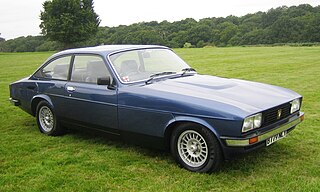
The Bristol Type 603 is a car that was launched in 1976 by British manufacturer Bristol Cars to replace the 411. With the 603 – introduced along with the Zagato-built 412 – the Bristol car underwent its first major facelift since the introduction of the 406 in the late 1950s. The design was to last until the marque's demise in 2011. Bristol's chief designer Dudley Hobbs strived to make the car more spacious and aerodynamic, while also using flatter body panels that would be easier to hammer.

The Daimler Majestic DF316/7 and DF318/9 luxury saloon was launched by the Daimler Company of Coventry in July 1958 and was in production until 1962. Edward Turner had been appointed Chief Executive of BSA Automotive in 1957 and promised new products, this car was to carry his new V8 engine still under development. The six-cylinder, four-door saloon, with new three-speed Borg Warner automatic transmission, power steering and vacuum-servo assisted four-wheel disc brakes was mechanically up-to-date for its time, but it had a heavy coachbuilt body of outdated construction on a separate chassis which kept the car's mass well above more modern designs and made it difficult to manoeuvre, despite the modern steering. The styling was already becoming outdated when the car appeared and became increasingly dated as lighter cars with monocoque construction appeared during the Majestic's production run.
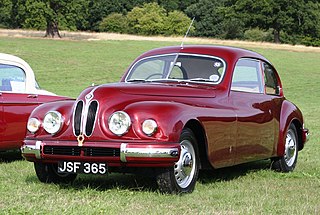
The Bristol 401 saloon and Bristol 402 cabriolet are British luxury sporting cars, produced between 1948 and 1953 by Bristol Cars, an offshoot of the Bristol Aeroplane Co. They were developed from the Bristol 400, which continued in production alongside the 401 and 402 until 1950.
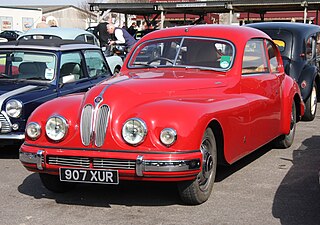
The Bristol 403 is a luxury car which was produced from 1953 to 1955 by British manufacturer Bristol Aeroplane Co.. The 403 was the third of the eventual five series of Bristols powered by the BMW-derived pushrod straight-six engine. It replaced the Bristol 401 and 402 in 1953 and continued in production for two years.

The Bristol 404 and Bristol 405 are British luxury cars which were manufactured by the Bristol Aeroplane Company. The 404 was manufactured from 1953 to 1958, and the 405 from 1955 to 1958. The models were successors to the Bristol 403. The 404 was a two-seat coupé and the 405 was available as a four-seat, four-door saloon and as a four-seat, two-door drophead coupé.

The Bristol 407 was a sports tourer car produced by British manufacturer Bristol Cars between 1961 and 1963. It was the first Bristol model to be made by the company after separation from the Bristol Aeroplane Company, which had built all previous Bristol models. Outwardly it resembled the 406, on which it was based, and which had been produced between 1958 and 1961.

The Bristol 408 is a British luxury car made by Bristol Cars between 1963 and 1966. Unusually for Bristol, a slightly revised version was launched during the middle of the model's production run in 1965 and known as the 408 Mark II.

The Bristol 409 was the third series of cars from British manufacturer Bristol Cars powered by Chrysler V8 engines. It was actually introduced before the older Bristol 408 went out of production and only gradually supplanted that model after a year.
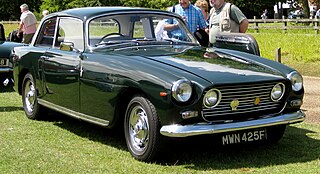
The Bristol 410 was the fourth series of Chrysler V8-engined models from British manufacturer Bristol Cars. It was the last Bristol to use the 5.2-litre (318 cubic-inch) engine originally found in the Bristol 407.

The Bristol 412 is a car which was produced by British manufacturer Bristol Cars from 1975 to 1986. Variants were produced as the Bristol Beaufighter, from 1980 to 1993, and as the Bristol Beaufort, from 1984 to 1994.

The Alfa Romeo Giulia is a compact executive car produced by the Italian manufacturer Alfa Romeo. Known internally as the Type 952, it was unveiled in June 2015, with market launch scheduled for February 2016, and it is the first saloon offered by Alfa Romeo after the production of the 159 ended in 2011. The Giulia is also the first mass-market Alfa Romeo vehicle in over two decades to use a longitudinal rear-wheel drive platform, since the 75 which was discontinued in 1992. The Giulia was second in 2017 European Car of the Year voting and was named Motor Trend Car of the Year for 2018. In 2018, Giulia was awarded the Compasso d'Oro industrial design award.

The Viper engine is a high-performance naturally-aspirated pushrod 2 valves-per-cylinder 90° V10 engine designed by Chrysler but with aluminum block castings designed by Lamborghini for use in the Dodge Viper. Despite its large displacement, it is based on the Chrysler LA V8.

The Bristol 406 Zagato is a British-Italian sports car that combines the technology of the Bristol 406 Saloon with a body designed and built by Zagato. This special model, often considered eccentric, was commissioned by Bristol dealer Tony Crook and was produced in very limited quantities. It is known for being lighter, smaller, and faster than the factory-bodied base car. In addition, some older Bristol chassis also subsequently received similar Zagato bodies. Today, the 406 Zagato is considered one of the most expensive classics within the brand’s lineup.

